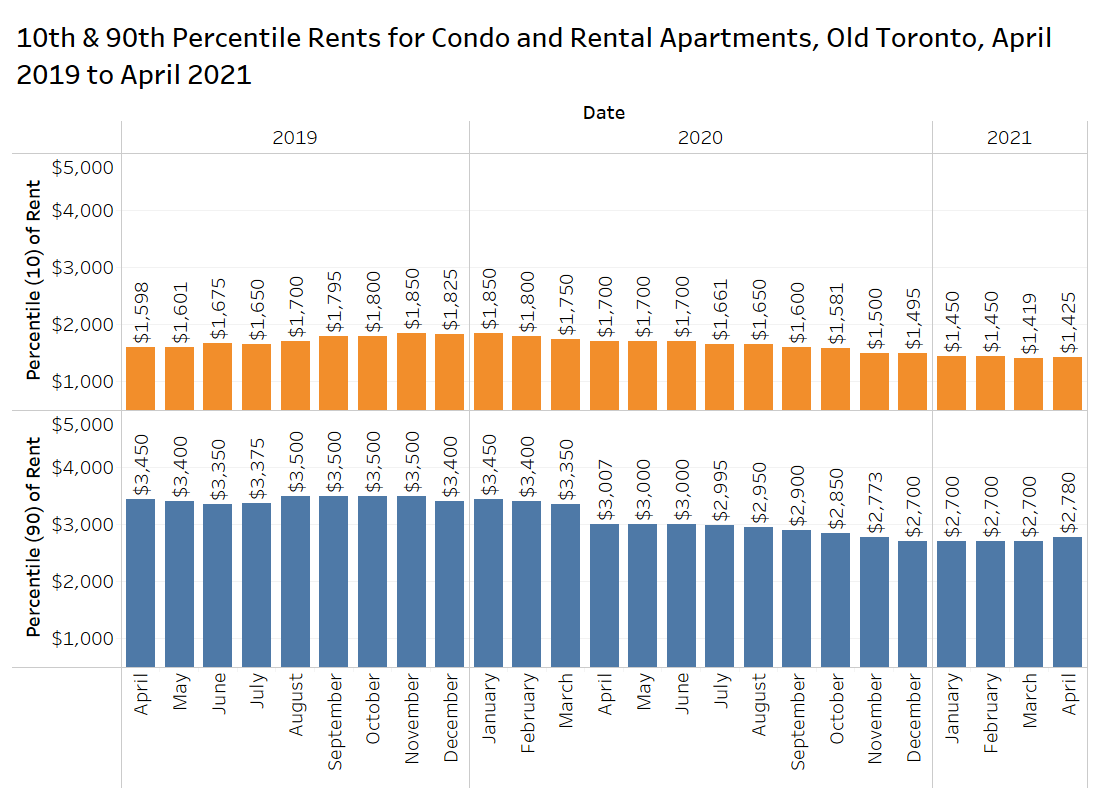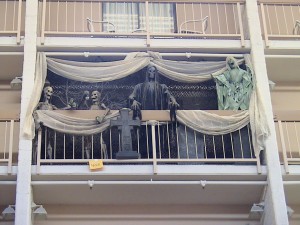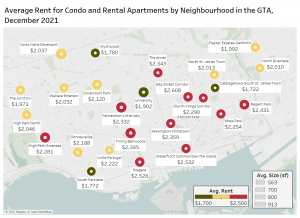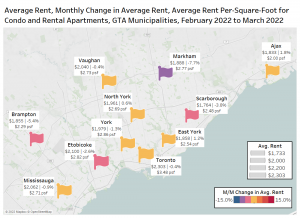Greater Toronto Area Rental Apartment Market
The following graphic presents data on the average and median monthly asking rents for GTA rental listings (all property types: basement apartments, rental apartments, condo apartments, townhouses and single-family homes) from January 2020 to April 2021 based on listings on TorontoRentals.com.
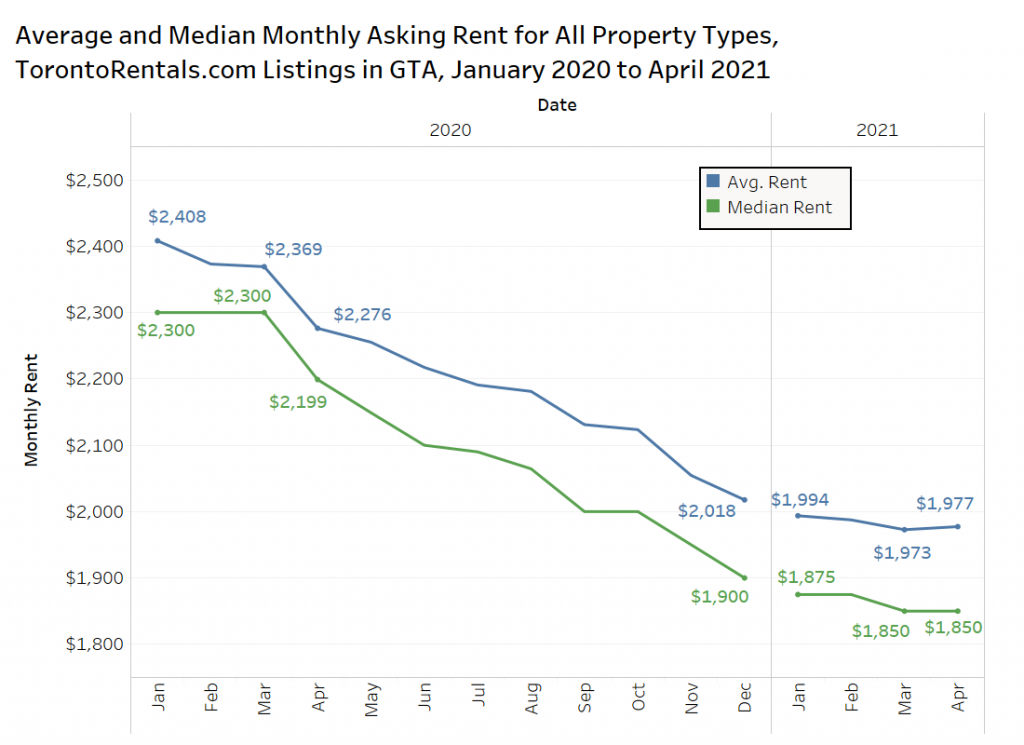
The average rent for all property types was $1,977 per month in April 2021. The dramatic declines in average rental rates over the last year appear to have leveled off.
Between January and December 2020, the average rent in the GTA decreased 16%, while so far in 2021, the average rental rate has decreased by less than 1%.
Per-Square-Foot Rent Levels in the GTA
This graphic looks at the average rent per square foot for all property types in the GTA from January 2020 to April 2021.
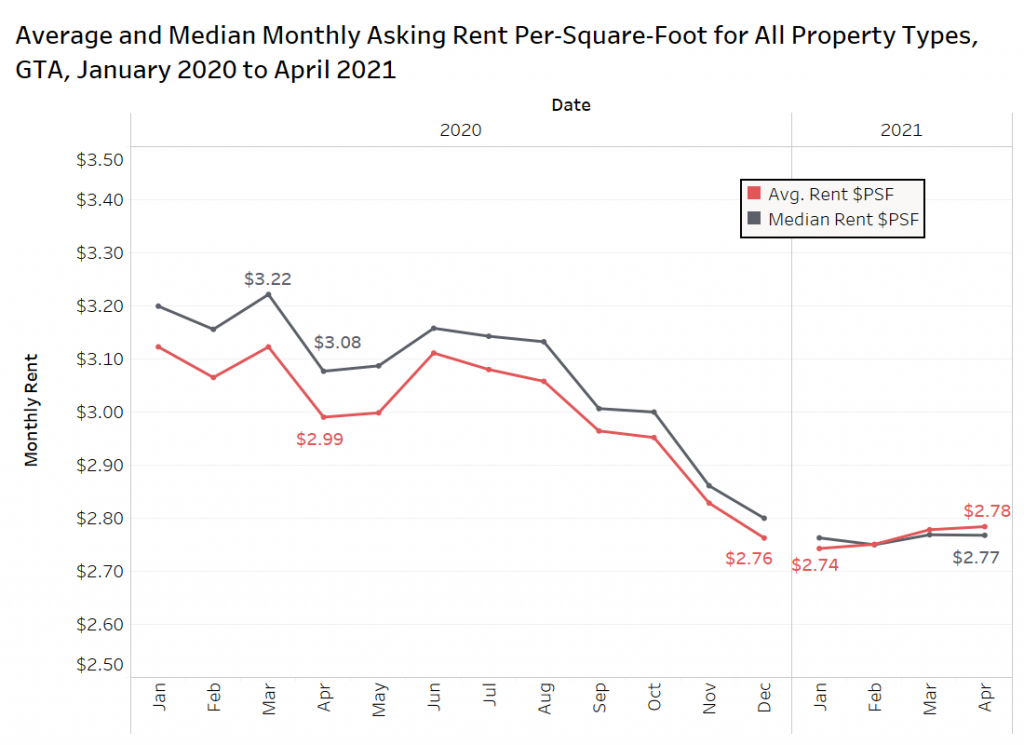
For most of 2020, the average rent per square foot steadily declined, ending the year at $2.76 per square foot in December 2020. In April 2021, the average rent per square foot was $2.78. While this represents a 13.7% decrease year over year, the average rent per square foot has stayed relatively stable throughout 2021 so far, ticking up $0.04 per square foot from January.
Furnished versus Unfurnished Rentals
The figure below presents data on the average rent and average rent per square foot for condo and rental apartments by the furnished level over the last 13 months in the GTA.
The average monthly rent for a furnished unit was 5.1% higher than the average monthly rent for an unfurnished unit in April 2021, while the average rent per square foot for a furnished unit was 6.1% higher than the average rent per square foot for an unfurnished unit.
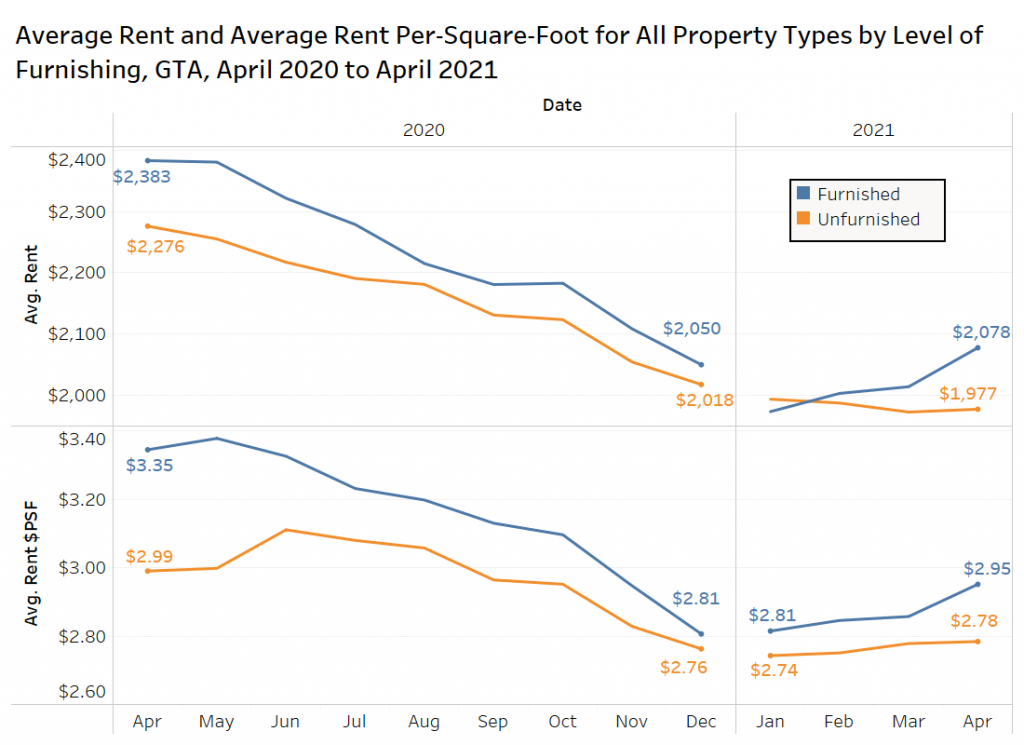
In April 2020, the average rent for a furnished unit was 4.7% higher than that of an unfurnished unit — so the disparity has not changed substantially from a year ago. However, the average rent per square foot in April 2020 for a furnished unit was 12% higher than the average rent per square foot for an unfurnished unit, showing that the price difference between furnished and unfurnished units has diminished moving from April 2020 to April 2021.
Unit Mix by Bedroom Type in the GTA
One of the factors contributing to the lower rent levels in the GTA is the high demand for large properties. These units are being leased quickly, and the number of three-, four- and five-bedroom homes for lease is much lower year to date in 2021 in comparison to 2020 and 2019.
The pie charts below show the breakdown of listings on TorontoRentals.com in the GTA by bedroom type during the first four months of the year in 2019, 2020 and 2021 (six- and seven-bedroom properties were eliminated).
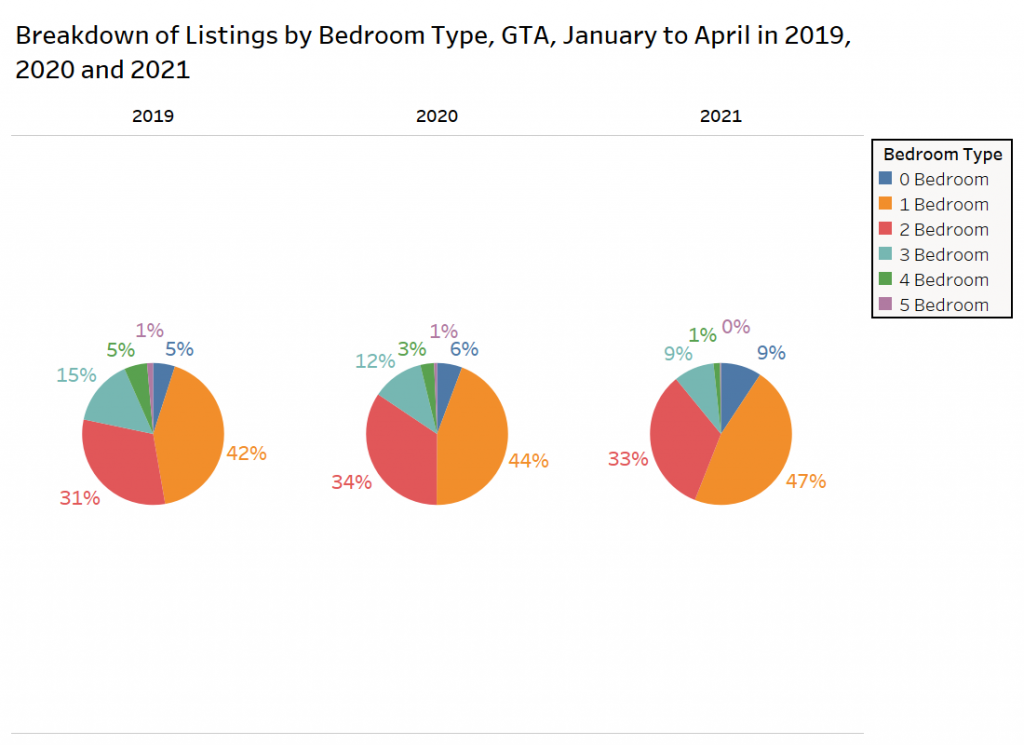
In 2019, the three-bedroom units made up 15% of the market, while four-bedroom units made up 5%, and five-bedroom units made up 1% (21% total).
In 2020, the three-bedroom segment shrank to 12%, while the four-bedroom segment decreased to 3% of the market and five-bedroom units again at 1% (the total for three-, four- and five-bedroom units came to 16% of the total).
In 2021, the market segment of larger units continued to shrink, as three-bedroom units made up 9% of the market, while four-bedroom units made up 1%. The five-bedroom units available in 2021 made up less than 1% over the total. Overall, these large units made up just 10% of the total, half of market share from 2019.
Average Rental Rates by Bedroom Type in the GTA
The figure below presents data on the average rent by bedroom type in the GTA from April 2020 to April 2021 for all property types. Five- and six-bedroom units have been removed from the chart.
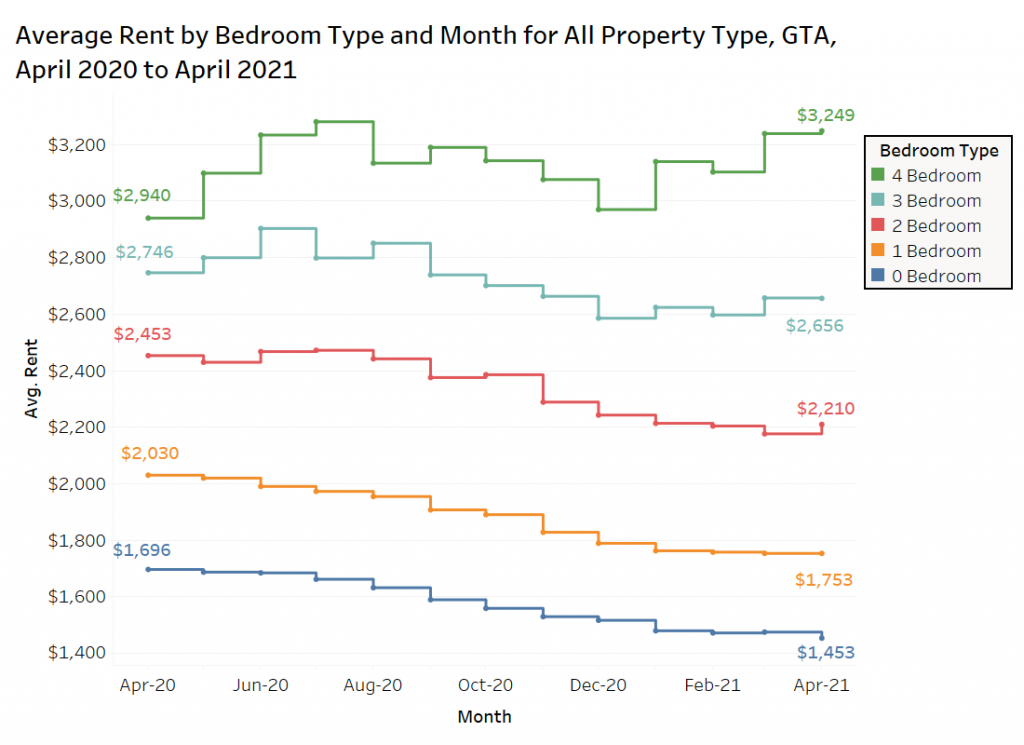
The rental rates for different bedroom types have diverged over the course of the past year. The average rent for four-bedroom units (primarily single-family dwellings) has increased, while the average rent for smaller units has decreased. Tenants are seeking larger properties while they work from home and their children learn virtually. With the stay-at-home order in place, many prospective tenants are looking for a property with a back yard.
The average rent for studio, one-, and two-bedroom suites are all down over 15% annually. Average rents in April 2021 were $1,453 for a studio, $1,753 for a one-bedroom, and $2,210 for a two-bedroom. All three were down by around $250 from a year earlier.
Four-bedroom units experienced an annual increase in average rent of 10% in April 2021.
Average Rental Rates by Property Type in the GTA
The following graphic presents GTA data on the average rent for single-family homes, condominium apartments, townhouses and rental apartments in March and April of 2020 and 2021 via TorontoRentals.com listings.
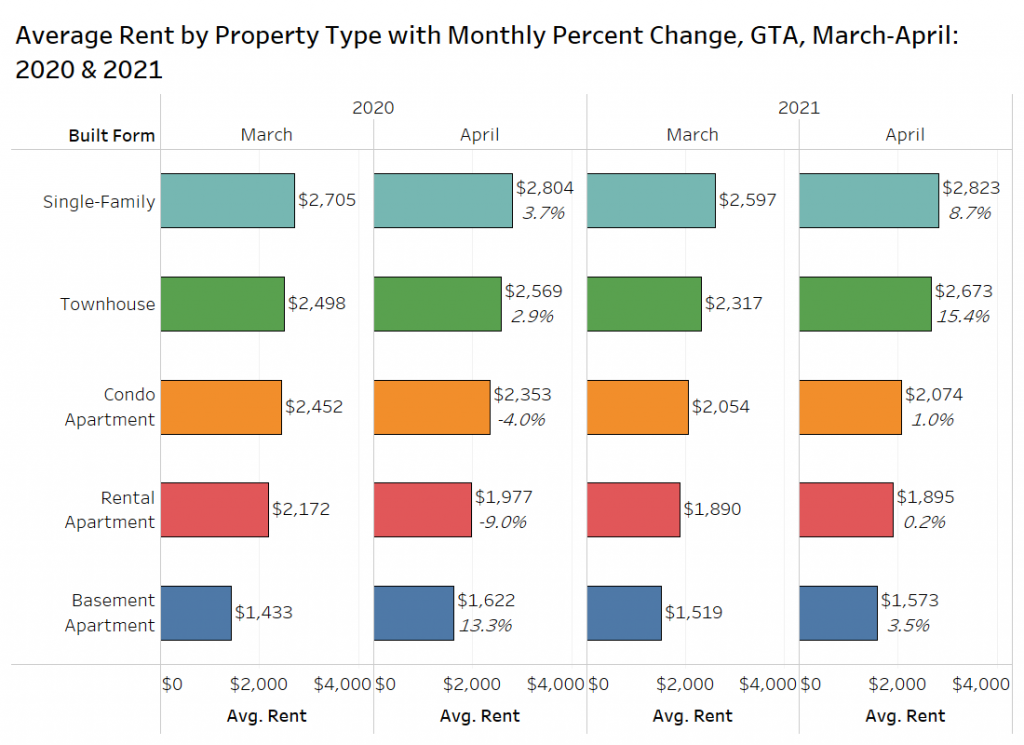
The average rent for a single family home in April 2021 was $2,823 per month, which represented a month-over-month increase of 8.7%, and a year-over-year increase of 0.6%. Single-detached rental rates are volatile because the homes can range widely in size, and there are different lot frontages and depths which play a factor in the asking rents.
The average rent for a townhouse in April 2021 was $2,673 per month, a month-over-month increase of 15.4%, the largest increase of all the property types. The sample size of townhouses is relatively small, leading to monthly volatility. The average townhouse was listed for 4% more than a year earlier.
Condo apartments were offered at an average monthly rental rate of $2,074 per month in April, which represents a month-over-month increase of 1%, and an annual decrease of 11.8%. The average rent for purpose-built rental apartments in April 2021 was $1,895 per month, a 0.2% month-over-month increase, compared to a 4% year-over-year decrease.
Lastly, the average rent for basement apartments in April 2021 was $1,573 per month. This represents a monthly increase of 3.5%, and a year-over-year decrease of 3%.
The increase in rents overall was not compositional, as rental rates increased across the board.
Average Rents by Municipality
Average rent for condominium and rental apartments in GTA municipalities in April 2021 is presented below. Toronto is broken up into its former municipalities, prior to amalgamation.
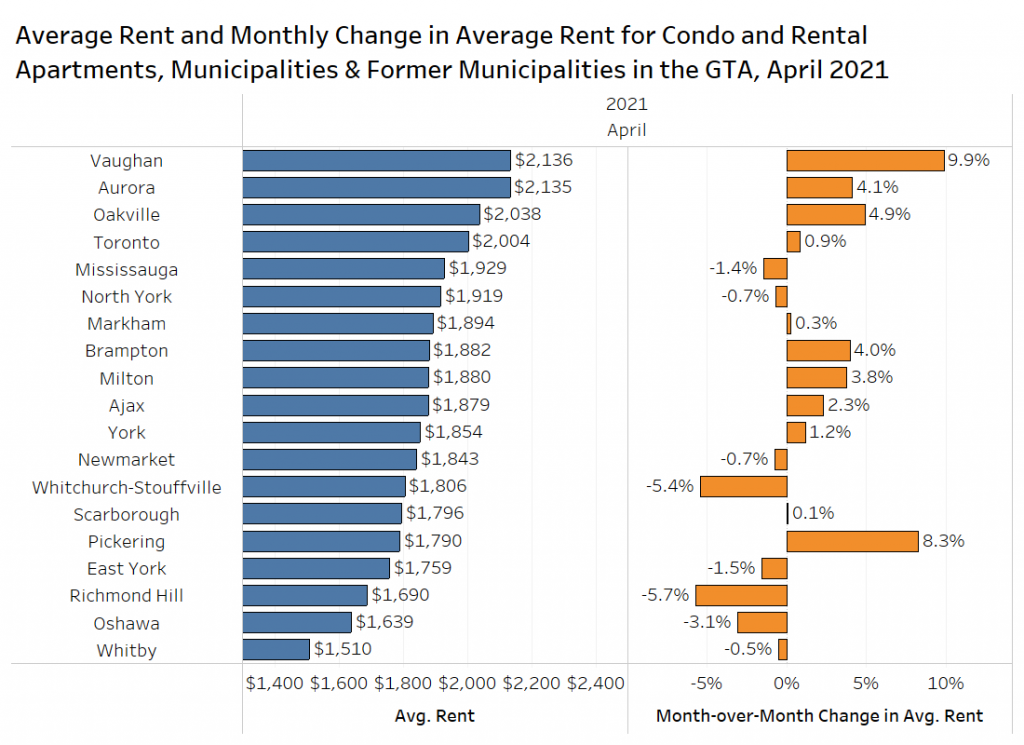
The average rent for a condo or rental apartment in Vaughan has experienced the largest month-to-month increase in April 2021, rising by nearly 10% to $2,136 per month. Pickering was a close second, experiencing a month-over-month increase of 8.3% to $1,790 per month. The sample size of listings in these municipalities is not large, and as a result, their average rental rates can fluctuate monthly.
Toronto, which has a robust sample of listings, grew by just under 1% month over month, and the data indicates that tenant demand is increasing downtown.
Whitchurch-Stouffville and Richmond Hill are the municipalities that had experienced the largest month-over-month decrease in average rent, both declining by over 5%. The average rent in Whitchurch-Stouffville was $1,806 per month in April 2021, while the average rent in Richmond Hill was $1,690 per month.
10th & 90th Percentile Rent Levels
The bar graph below shows the 10th percentile rent level for condo and rental apartments in the former City of Toronto (pre-amalgamation boundaries), which is essentially the cheapest rents in the market (there are always a few outliers we eliminate). The 90th percentile is also shown, which is essentially the luxury rental market.
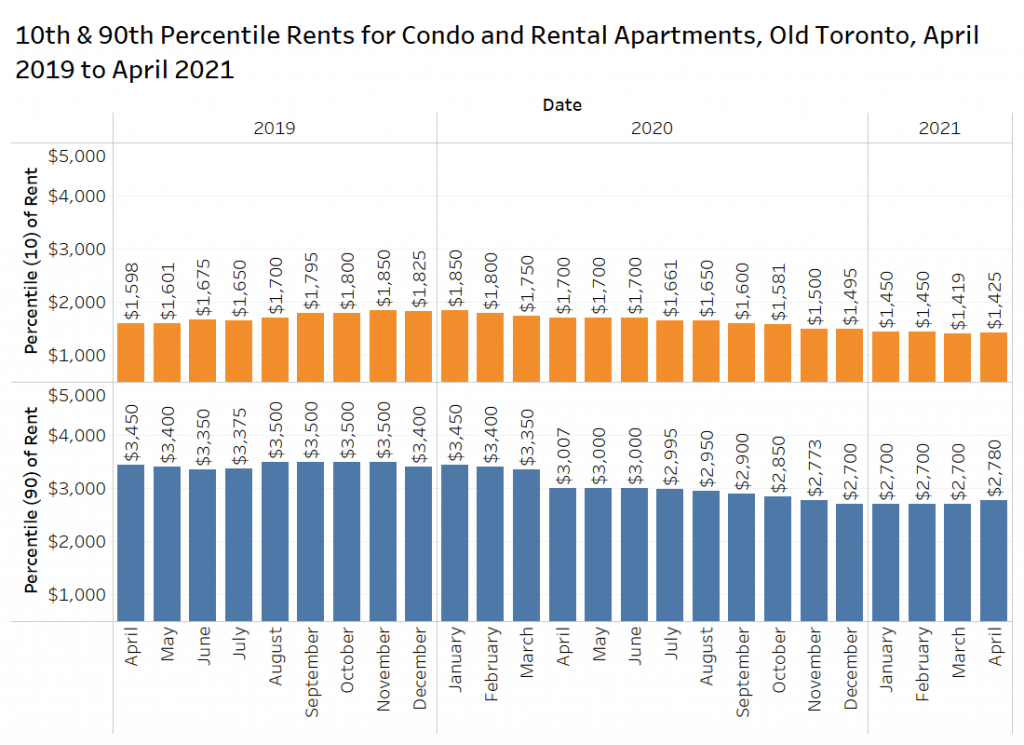
The 10th percentile rent peaked at around $1,850 in late 2019 early 2020, but has since steadily declined to sit at $1,425 in April 2021. This is a decrease of 22% from the peak, and good for tenants with limited budgets.
Similar to the 10th percentile, the 90th percentile peaked in late 2019, reaching a height of $3,500. In April 2020, the first month of the pandemic, the average decreased 10% month over month to $3,007. Since then, the average rent has steadily declined, hitting a low of $2,700 in December 2020. The average rent in April 2021 for a unit in the 90th percentile was $2,780, which is down 21% from the peak. The luxury market and the attainable rental market have declined by the same amount.
Condo & Rental Apartment by Neighbourhood in Toronto
The chart below shows the average rent, the annual change in average rent, and the average rent per square foot by neighbourhood for condominium and rental apartments in Toronto for January to April 2021 using listings data from TorontoRentals.com.
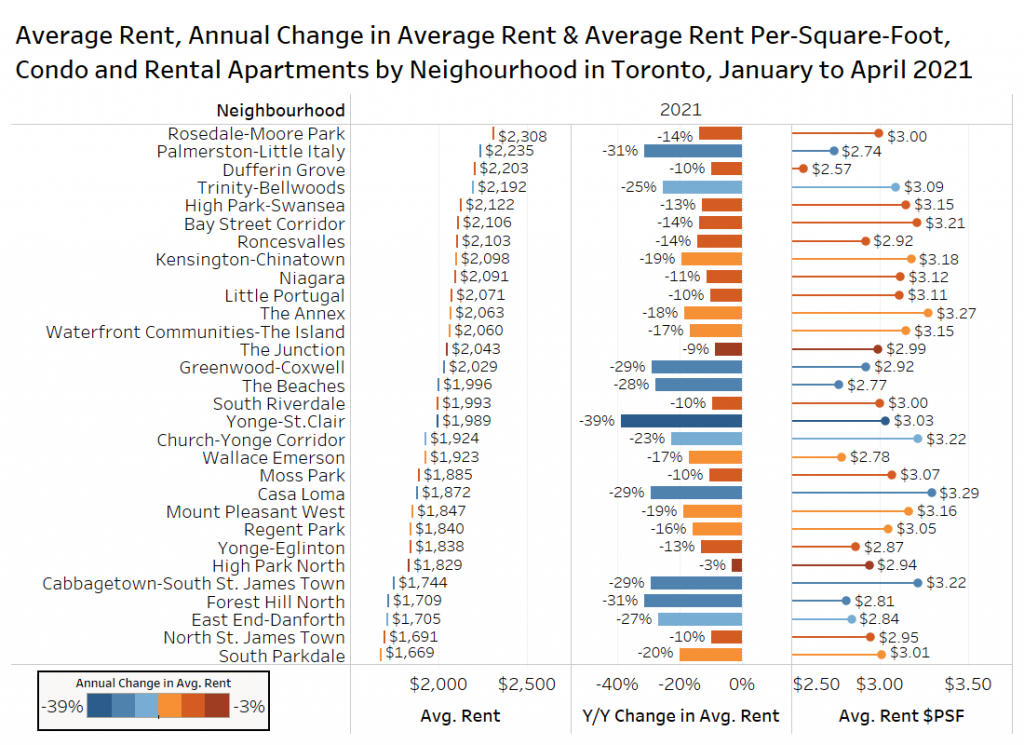
The most expensive rent this year was in Rosedale-Moore Park at $2,308 per month or $3 per square foot (769 square-foot average), which is down 14% from the first four months of 2020.
In the Yonge and Eglinton area, where the average rent is $1,838 per month or $2.97 per square foot (619 square-foot average) year-to-date in 2021, the average rent declined by 13% year over year.
High Park North had the lowest annual decline at 3%, while Yonge-St. Clair experienced the biggest decline at 39%. The composition of the listings plays a factor in movements in the average rent on a monthly basis. If there were a lot of large units for rent last year and a lot of smaller units for lease this year, the average rent is lower, but it may not reflect landlords actually lowering rents.
Annual Change in Rent Per Square Foot for Condo and Rental Apartment Projects
The chart below looks at condominium and rental apartments with at least 20 listings on TorontoRentals.com in January to April 2020 and the same period this year.
The average rent per square foot year to date is shown, as well as the annual change in rent per foot.
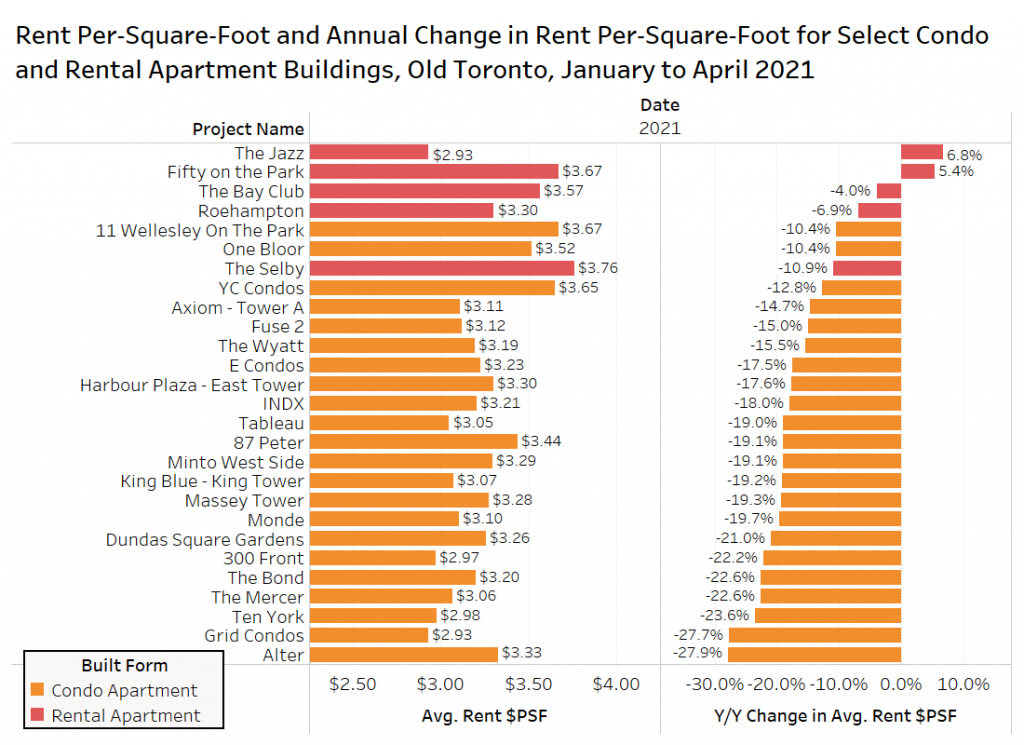
The purpose-built rental apartments are clustered near the top of the list,. These listings are more likely to offer rental incentives.
The only properties to experience a year-over-year increase in average rent per square foot were The Jazz, and Fifty on the Park at 6.8% and 5.4% respectively — both are purpose-built rental apartments.
Many condominium apartments have experienced significant year-over-year decreases, with seven projects experiencing a yearly decline of over 20%. The projects that experienced the most significant declines were Alter and Grid Condos which experienced year-over-year decreases of 27.9% and 27.7%, respectively.
Conclusion
Covid lockdowns and vaccine setbacks in Toronto have forced many employees to continue working from home. There remains strong demand for larger units in the suburban areas. Rents increased month over month in Vaughan, Aurora, Oakville, Markham, Brampton, Milton, Ajax and Pickering. Average rents declined month over month in North York, but were up slightly in both the former cities of Toronto and Scarborough.
The rapid declines in rental rates experienced in 2020 have dissipated in 2021, as the average monthly rental rates as well as the average rents per square foot appear to have remained fairly steady over the past four months.
Despite more vaccines getting into arms and an inevitable end of the lockdowns in the GTA, the work-from-home trend looks like it’s here to stay for many workplaces in 2021. This most likely means the rental rates for the smaller units in the downtown area will be slow to recover, while the rental rates for larger units in the suburbs will continue to be popular in the foreseeable future.
Bullpen Research & Consulting and TorontoRentals.com believe rents will start to pick up in the fall, but it won’t be until 2022 that we see a rapid rise in rental rates when the borders are reopened and university students return to the classroom.
